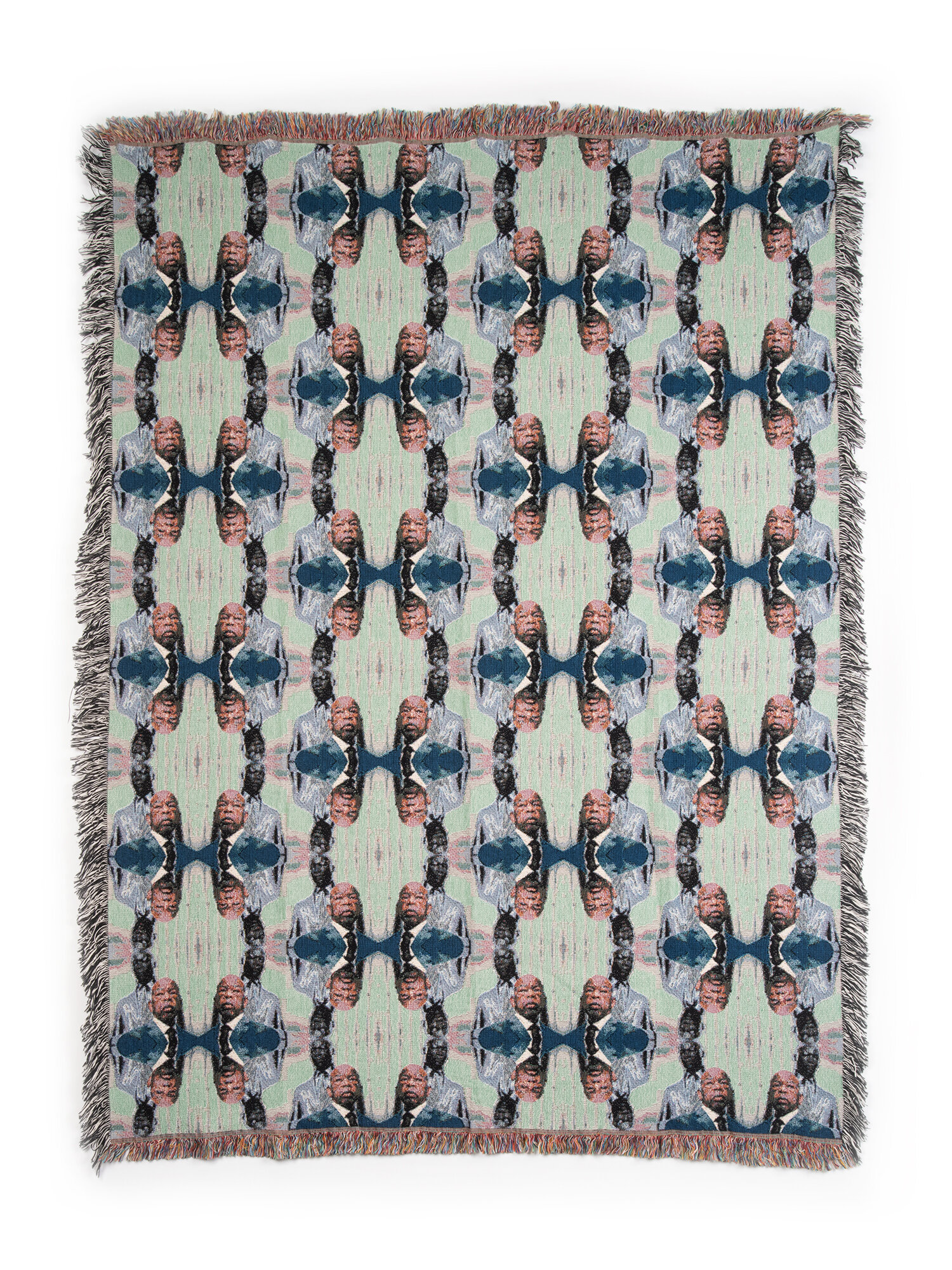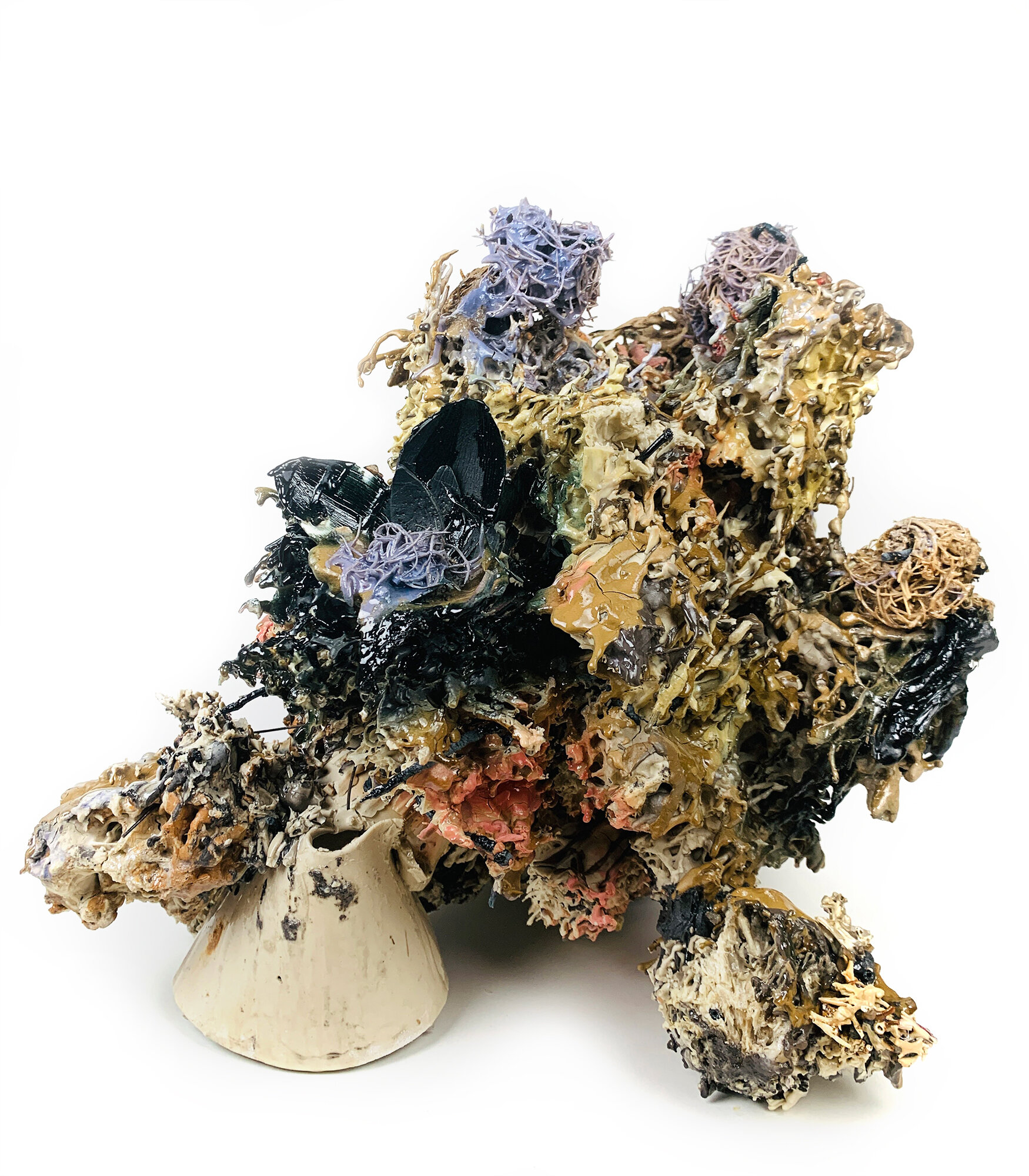Intertwined
AKINBOLA, LOCKE, RUBIN
Exhibiting Artists:
Anthony Olubunmi Akinbola, Steve Locke, Tammie Rubin
Exhibition Dates:
July 16 - September 24, 2021
Opening Reception:
Friday, July 16, 2021, 5:00-9:00pm
Artist Talk:
Steve Locke: Saturday, July 24 @ 11:00am
Intertwined: Meditations on Legacy, essay by Tiffany D. Gaines
Intertwined: Akinbola, Locke, Rubin
Intertwined brings together the work and dynamic practices of three contemporary Black artists: Anthony Olubunmi Akinbola, Steve Locke, and Tammie Rubin. As Black artists working in America, each of their bodies of work present manifold understandings of Black culture and lived experience, and their practices, too, are joined through the use of embroidery, sewing, painting, assemblage, and ceramics.
Intertwined is the culmination of years-long conversations with each artist to understand their methods, practices, artwork, and through this investigative process materials are transfigured in surprising ways. Each artist within this exhibit creates artwork that unpacks collective histories around race and identity, as well as the effects of white supremacy, and bodily violence.
Akinbola, Locke and Rubin each grapple with symbols of cultural violence, or those historically deemed by dominant culture to be lower or without merit, and the artwork included in this exhibition reclaims these sites to promote ideas of social justice.
Anthony Akinbola’s Camouflage series incorporates du-rags (do-rag, durag), colorful nylon and silk scarves used in the maintenance of black hair. The works push against the cultural and historical evocations surrounding black bodies while engaging with the predominantly white legacies of Color Field and Action painting. Akinbola’s works offer a couture synthesis of painting and sculpture, and reimagine the construction of identity through original treatments of color and texture. Characterizing his works as “metaphors for what a first-generation existence might look like,” Akinbola unpacks the rituals and histories separating Africa from Black America.
“The origins of do-rags are often linked to American slavery, when women wore head-wraps in the field to protect them from the punishing heat. In some regions in the South, black women were required by law to cover their hair as a mark of enslavement. These same women also used their head wraps as beauty embellishments that, depending on how they were tied, signified communal identities. Their current use—to create and preserve certain hairstyles—came later.”
Steve Locke’s artwork within Intertwined highlights the role of tapestries as vehicles for narrative within art history, while also seeing them as domestic tools of comfort and vehicles of texture. Within each of Locke’s tapestries Black historical figures and activists are presented and abstracted into mandala-like showers of geometry. The artist’s tapestries are a cultural matrix where aesthetics, history, sociology, folklore, and survival meet and deify Black figures whose visual presence embedded within each tapestry serves as a visual salve.
Each of Locke’s tapestries negotiate scale and visibility through their weaving, and each seek to reach into history and activate communal and shared histories through touch. Drawing inspiration from the material effects of tapestries over time, Locke’s artwork questions the viability of symbols offered into visual culture, while holding space for these objects to offer “comfort from the ancestors.” The resultant artwork looks to the ancestors of the civil rights movement as a mode of reflection while employing a cacophonous tension of figure, ground, form, and color to offer a corollary to the contemporary struggles of Black people within America.
Tammie Rubin is a visual artist who transforms familiar objects into mythic sculptures and installations that explore the gaps between the readymade and the handcrafted object. Her material-and-process-driven works open up dream-like spaces of unexpected associations and dislocations.
In speaking with Tammie Rubin about her Always & Forever (forever ever ever) series the artist builds from her signature cone forms from earlier series, with these remaining visible amid a tangle of organic and inorganic forms. Much of the organic work has been built from the Texas ball moss, a grey clump of growth that takes root in the branches of oak trees and bushes through the Texas landscape. The assumption about ball moss is that it’s a parasitic organism, draining the life of plants that it occupies. But the reality is more complicated, as it’s actually an epiphyte, a non-parasitic plant but it still plays a role. Tammie has been using it as a signifier of conflict and clashes. A metaphor for anxiety.
Similarly to Akinbola and Locke’s artwork, Rubin employs symbols of cultural conflict and turns them into sites of ritual, reverence, fear, and misalignment. Her signature cone forms are dotted with eyes, outlines of states, and inscribed with details of her family’s migration from the south to the north; they form an imposing cohort of hooded figures void of eyes or bodies, but alive with psychic malice. Rubin’s work is a reminder that Black lives continue to flourish, despite efforts to stop them.
WORKS
ABOUT THE ARTISTS
Anthony Olubunmi Akinbola (b. Columbia, Missouri) is a New York-based artist and first-generation American raised between Missouri and Nigeria. His multifaceted compositions celebrate and reconcile diverse cultural narratives, creating multilayered works of art that engage consumption, respectability, and the commodification of Black culture. Akinbola was selected for the Anderson Ranch Art Center Residency in 2017, was awarded the Van Lier Fellowship in 2019, and was an artist in residence at Galerie Krinzinger, Vienna in 2020. He has had solo exhibitions at Night Gallery, False Flag, The John Michael Kohler Art Center, The Queens Museum, and featured in exhibitions at The Zuckerman Museum of Art, and The Verbeke Foundation, Belgium, among others.
Steve Locke (b. Cleveland, OH, raised Detroit, MI) is a New York-based artist whose paintings, drawings, sculptures, and installations live at the intersections of portraiture, identity, and modernism. From the seductive nature of his paintings to the familiar but unreliable record of his photographs, he directs our gaze to help us look critically and unflinchingly at our shared history. Locke recontextualizes images and marries the contemporary and the historical, showing that the sins of the American past are alive and well and beg to be addressed. Instead of solely memorializing victims or revisiting trauma, he steers the viewer to the source of the violence. He refuses to let us look away from our complicit role but stands beside us as we face it. Locke is a former professor at Massachusetts College of Art and Design in Boston, and currently teaches at the Pratt Institute.
Locke has been the subject of several exhibitions, including Samsøn Projects, Jack Shainman Gallery: The School, Mendes Wood, and there is no one left to blame, curated by Helen Molesworth at the Institute of Contemporary Art in Boston, traveled to the Museum of Contemporary Art Detroit, and that last time we touched the water at the Hudson Opera House in Hudson, NY. Locke was awarded the Pollock-Krasner award in 2015 and a Guggenheim Fellowship in 2020. He is represented by LaMontagne Gallery in Boston, MA.
Tammie Rubin (b. Chicago, Il) received a BFA in Ceramics and Art History from the University of Illinois, Urbana-Champaign, and an MFA in Ceramics at the University of Washington in Seattle. Born and raised in Chicago, Rubin currently lives in Austin, Texas where she is an Associate Professor of Ceramics & Sculpture at St. Edward’s University. Rubin has exhibited widely in solo and group exhibitions, recent selections include Hessel Museum of Art at Bard College, The Houston Center for Contemporary Craft, The South Dallas Cultural Center, and The Carver Museum. Rubin founded Black Mountain Project along with fellow Austin-based artists Adrian Aguilera and Betelhem Makonnen, and she is a member of ICOSA Collective, a non-profit cooperative gallery. Rubin recently completed a Facebook Artist in Residence project and has an upcoming solo exhibition at The East | West Galleries at Texas Woman’s University.


































